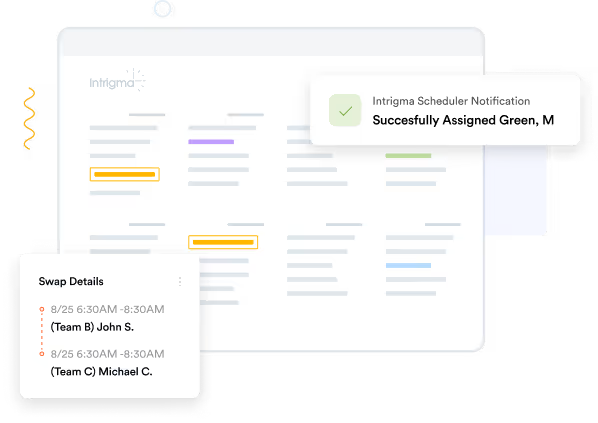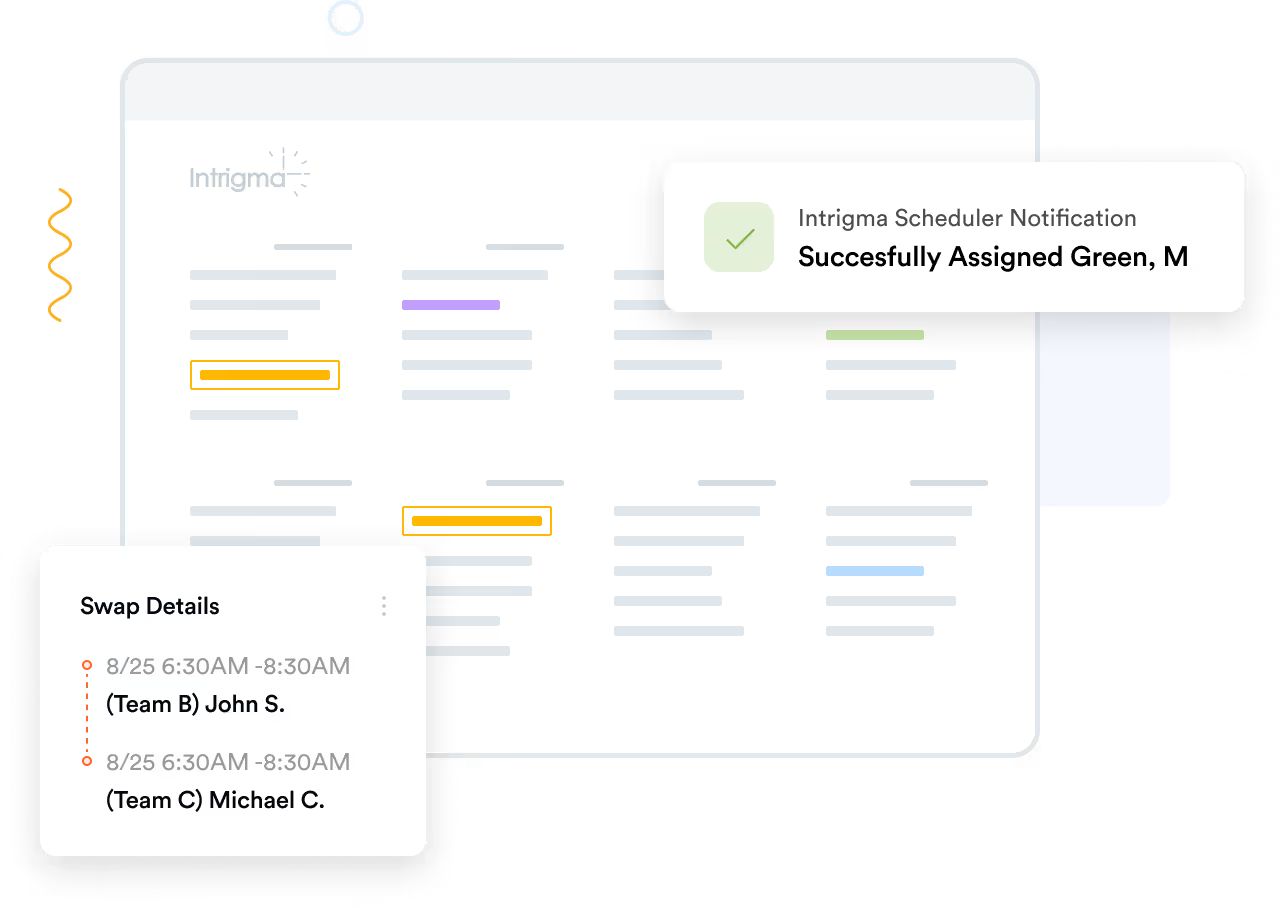Savings And Improved Patient Carethrough Streamlined Nurse Scheduling
Critical Issues
The Results
Hospital Profile
Southampton Hospital, located on the south fork of Long Island, NY, has long experienced seasonal patient volume increases during the tourist-filled summer months. These increased patient demands combined with nursing union scheduling mandates created both a budgetary and operational need to staff and schedule efficiently. Nurse managers logged up to 40 hours per month per scheduler preparing each nursing unit’s schedule. Schedules would often require finding and calling in nurses, union mediations over scheduling conflicts, and overtime pay. Identifying the budget and performance impact on the hospital, Southampton leadership made the strategic decision to deploy Intrigma Scheduler for Nursing. Today the Hospital has achieved its goals: reducing time spent scheduling by 90%, improving Press Ganey scores, and reducing labor costs. Southampton is also in compliance with union mandates and facilitates a collaborative culture of excellence.
The Challenge
At Southampton, as in many hospitals, the scheduling process directly affects the nurses’ labor budget, retention, productivity, and patient satisfaction. Nurse managers tasked with preparing the schedules found it complicated, tedious and distracting. Emergency Department nurse manager Katrin Diana, RN BSN described the process: “I would often take the schedule home and complete it over the weekend, and still it took 30 to 40 hours each month to prepare.”
“The schedule greatly affects the budget, morale and teamwork of the nurses, so it has to be built correctly.”
Katrin Diana, RN, BSN
Diana frequently struggled with situations where too many nurses would be off on the same day. “It was a free for all, and caused many challenges,” she said. “There was an absence of personal accountability as nurses were simply unaware of what their colleagues had requested for vacations and time off.” Resolving such conflicts was further complicated due to union rules mandating that scheduling preferences be based on seniority - requiring additional time from Diana. Additionally, every month, time was spent finding replacements for absences, which meant calling in additional nurses to cover scheduling holes and incurring overtime costs.
As time consuming as scheduling was, failing to prepare an accurate schedule carried more severe consequences. Unbalanced schedules can increase overtime utilization and further strain the nursing teams. “I had to make sure the schedules were always prepared adequately” she said “because when the schedule is not prepared correctly there are significant financial and retention risks.” According to Diana, the cost for replacing a nurse includes an 8 week orientation period for the new recruit that alone costs upwards of $20,000. “That’s not including overtime labor costs, preceptor pay, education department costs, recruiting costs, or the disruption to the department,” she said. Of course, satisfaction or dissatisfaction with the schedule directly affects nursing staff performance and Press Ganey scores.
The Solution
Following a review of various alternatives, Southampton Hospital decided their best opportunity to save time, manage labor costs, maintain good nurse retention rates, and improve Press Ganey scores was to deploy Intrigma SchedulerTM for Nursing. For the Emergency Medicine department, Diana chose to utilize Intrigma’s self-scheduling module. Through consultation with Diana, Intrigma’s scheduling team configured the software solution to reflect the exact parameters for each nurse. These parameters included contractual work quotas, overtime rules, union-mandated seniority rules, regular and seasonal par level baselines, vacation policies, and personal preferences. In less than two months, Diana and her staff were using the new scheduling model.
Today, Diana sets the par levels within Intrigma Scheduler according to the budget and departmental needs, and the nurses then select their own assignments online. Diana completes the scheduling task in fewer than 3 hours per month – in one tenth of the time previously spent.
“Basically, when the par levels are set correctly, the schedule makes itself.”
Now the responsibilities of scheduling fall to the nurses themselves; filling shifts, reorganizing assignments and resolving scheduling conflicts are no longer on the manager’s already full plate.
Throughout the month, Diana monitors workload distributions using the Tracker and Par Level views in the software. These workload distributions are organized in clear categories including weekend, night, and overtime assignments. Each category shows monthly and year-to-date totals for each nurse. All significant deviations are automatically highlighted and accounted for. Additionally, seasonal staffing variations are handled as the software can be easily adjusted. Diana’s current scheduling work involves making adjustments to the schedule only where absolutely necessary. Additionally, meeting the staffing budget is greatly simplified. Diana said, “We use Intrigma Scheduler as a budgeting tool since our unit has seasonally varying staffing needs that must stay within the budget.”
The nurses find the self-scheduling interface very simple and convenient to use. They select their shifts from their work or home computer or their mobile phone. Each nurse can see all of the other nurses’ assignments and requests along with the department’s par level reqirements. These insights and transparency when selecting personal assignments make the self- scheduling process accountable, convenient and easy.
“With self-access, our nurses can make their schedules from home with their families. It’s convenient, easy to use, and they absolutely love it.”
One additional benefit is that nurses now trade their assignments online, subject to a manager’s review. Such a trades initiate an email to the available nurses, who respond quickly. Behind the scenes, Intrigma’s rule engine ensures that all budgetary, seniority rules, and personal preference considerations are calculated accurately and maintained throughout the entire self-scheduling process. Union rules are automatically enforced, so if, for example, a senior nurse takes an assignment, the system may bump other junior nurses down to the next available assignment on the same day according to agreed upon logic.
The Results
Since implementing Intrigma SchedulerTM for Nursing, Southampton realized savings of $300,000 per year from the 90% reduction in nurse managers’ time spent scheduling, the reduction in unnecessary overtime labor costs, and improved retention. The Hospital’s Press Ganey ranking increased from the mid-80th percentiles’ to the upper 90th percentile. According to Diana, there’s an obvious correlation there:
“When the staff are happy, the patients are happy.”
“Self-scheduling empowers the nurses to work together. And the nurses’ union was very positive over the fact that the solution empowers nurses to exercise self- governance.”
When Diana, nurses, and HR staff inform recruits about the self-scheduling solution, it is presented in hiring interviews as a perk along the hospital’s other popular workplace benefits, which at Southampton even include a free massage room. The nurses describe self-scheduling as easy to use and report accessing the system from home regularly. Diana says that the perceived and real control the nurses have over their own schedules drives a culture of teamwork, collaboration, and high motivation. With these accomplishments and improvements in their workplace culture, Southampton Hospital has set a new goal of achieving MAGNET status, a goal that will greatly assist in attracting and retaining top talent and delivering excellent care.
.svg)












